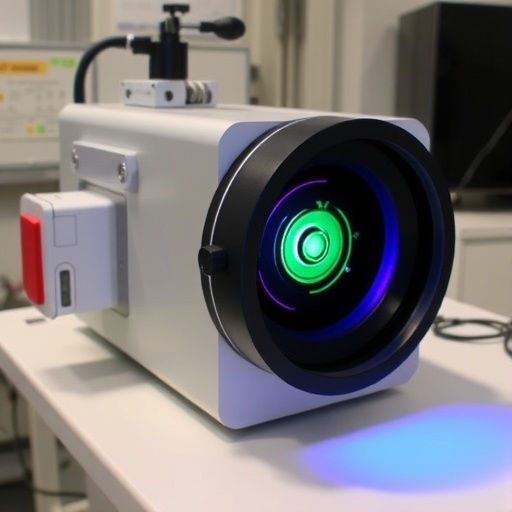In a groundbreaking development that promises to revolutionize optical spectroscopy, researchers at Shanghai Jiao Tong University have unveiled an ultra-compact chaos-assisted computational spectrometer. Led by Professor Xuhan Guo and Yikai Su, the team has innovatively harnessed chaotic dynamics traditionally considered a hindrance, transforming them into a powerful tool for spectroscopic analysis. Published in Light: Science & Applications, this new spectrometer remarkably overcomes the conventional three-way trade-off that has long limited spectrometer design: physical size, spectral resolution, and operational bandwidth.
Optical spectrometers are critical for diverse scientific and industrial fields, enabling precise measurement of light spectra for applications ranging from environmental monitoring to biomedical diagnostics. Historically, achieving high spectral resolution, broad operational bandwidth, and minimal device footprint simultaneously has posed significant engineering challenges. The traditional methods to enhance one parameter typically degrade the others, limiting device miniaturization and practical usability. The chaos-assisted spectrometer devised by Guo, Su, and colleagues deftly circumvents these limitations through a paradigm shift in device design.
Central to their innovation is the exploitation of chaotic behavior in optical cavities. Unlike conventional resonant cavities, whose periodic and predictable modal patterns impose constraints on spectral diversity, chaotic cavities produce highly irregular and complex distributions of resonant modes. This complexity translates into a highly decorrelated optical response matrix, which is crucial for computational spectroscopy. Whereas previous designs required intricate cascading arrangements with footprints stretching to millimeters, the chaotic cavity enables a highly random yet stable spectral response within a footprint merely spanning 20 by 22 micrometers — a scale compatible with integration alongside emerging nanomaterial-based systems.
The chaotic cavity in this spectrometer is meticulously engineered by smoothly deforming the boundary into a Limaçon of Pascal shape. This geometric tailor-making destroys periodicity and spatial symmetries present in conventional circular microdisks, as demonstrated by the team’s phase-space analyses. The comparison between the circular microdisk cavity and the Limaçon-shaped chaotic cavity reveals stark differences in their Poincaré surface of section (PSOS) distributions. While the circular cavity exhibits strong periodicity and well-ordered ray trajectories, the chaotic cavity shows a complex, scattered pattern indicative of highly sensitive dependence on initial conditions, the hallmark of chaos.
This high degree of chaos is not merely a curiosity but the cornerstone enabling an ultra-high spectral resolution of 10 picometers within an operational bandwidth spanning 100 nanometers. Crucially, the device preserves these impressive performance metrics without necessitating complex optical setups or large interferometric structures. The response matrix derived from the chaotic microcavity supports robust identification and reconstruction of input spectral signals, a feat demonstrated in extensive experimental validations reported by the team.
Power consumption is a pivotal metric for on-chip spectrometer applications, especially in the rapidly growing realm of portable and battery-powered devices. Conventional integrated spectrometers often consume more than 30 milliwatts, which constrains their use in low-power platforms. The chaos-assisted spectrometer excels in this domain as well, requiring only 16.5 milliwatts of power. This significant reduction is enabled by efficient optical coupling strategies and the intricate design of the chaotic cavity, underscoring the device’s suitability for mobile applications and integration into consumer electronics.
The removal of grating couplers in favor of edge coupling has further enhanced the operational bandwidth of the device to over 300 nanometers. Edge coupling mitigates wavelength-dependent losses associated with gratings, enabling broader spectral coverage without sacrificing efficiency. This adaptability aligns well with the device’s design philosophy, which emphasizes scalability and versatility. By tuning the chaotic cavity dimensions in alignment with silicon’s transparency windows, or by adapting the design for alternative material systems, the spectrometer can be transplanted across different wavelength regimes, covering visible, near-infrared, and potentially mid-infrared bands.
This breakthrough paves the way for a new generation of computational spectrometers that can not only deliver unparalleled performance metrics but also be seamlessly integrated onto chips at wafer scale. Such integration holds transformative potential for fields demanding high-throughput spectral sensing in compact, cost-effective formats. The ability to embed advanced spectral analysis capabilities within tiny footprints enables applications in environmental sensing, medical diagnostics, wearable health monitoring, industrial process control, and beyond.
Importantly, the researchers highlight the democratization potential of this technology. Existing mobile consumer devices possess sufficient computational and power resources to host the chaos-assisted spectrometer, enabling the emergence of portable, low-cost spectroscopic tools accessible to a broad user base. This empowerment may redefine how spectral information is gathered and utilized in everyday scenarios, catalyzing innovations across disciplines and industries.
Furthermore, the theoretical and practical insights gained through this work extend beyond immediate spectroscopic applications. The exploitation of chaos as an enabling phenomenon challenges entrenched design conventions in photonics and opens new avenues for devices leveraging complex dynamics. By strategically designing microcavities to induce chaos, photonic devices can achieve richer modal diversity and spectral response characteristics, enhancing functionalities across sensing, communication, and computation.
As the researchers continue to refine their design and explore integration strategies, the broader photonics community anticipates exciting developments stemming from this marriage of chaotic dynamics with computational spectroscopy. The synergy between fundamental physics and practical engineering embodied in this work epitomizes the kind of innovative thinking driving progress in modern optical technologies.
In conclusion, the miniaturized chaos-assisted spectrometer platform devised by Guo, Su, and their collaborators stands as a landmark achievement that redefines the limits of spectral analysis in ultra-compact devices. By transforming chaos from a traditionally avoided phenomenon into a critical resource, the team successfully reconciles the longstanding trade-offs among size, resolution, and bandwidth. This hallmark innovation not only advances the frontier of on-chip spectrometry but also signals a promising future where chaos-inspired photonics enables unprecedented capabilities in sensing and information processing.
Subject of Research: Chaos-assisted computational spectrometry, optical microcavities, ultracompact spectrometer design
Article Title: Miniaturized chaos-assisted Spectrometer
News Publication Date: Not specified in the article
Web References: DOI 10.1038/s41377-025-01984-x
References: Guo, X., Su, Y., et al. “Miniaturized chaos-assisted Spectrometer,” Light: Science & Applications.
Image Credits: Yikai Su et al.




